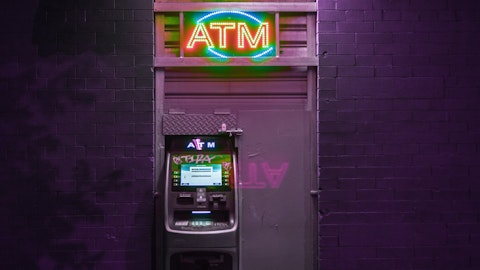John Turner: Yes. I’d just add two things, Ebrahim. One is we continue to grow consumer checking accounts and consumer households that contributes to growth. Secondly, we had the best year we’ve probably ever had in treasury management as we see increases in the number of operating accounts that we’re originating and services we’re providing to customers. And then finally, Wealth Management had maybe the best year it’s had certainly in some time, and we expect wealth management fee revenue to continue to grow in 2024.
Ebrahim Poonawala: That’s helpful. And just one other one, David. I guess the one flex on deposit pricing is your loan-to-deposit ratio at 77% just give us a sense of is this steady state in somewhere in the mid- to high 70s where you see running the bank going forward? Or if we get cut, you could see this ratio drift into the 80s and that probably provides you some pricing flexibility. Thank you.
David Turner: Yes. So we really don’t run the bank trying to solve for our loan deposit ratio. It’s just kind of a result of all of our activities that we have. At 77% were a little bit lower than the peer median by 2, 3 points. It gives us some flexibility to not have to put a lot of pressure on the deposit base. Remember, opening comments where we want to be fair and balanced with regards to our customers, making sure that we were competitive but we don’t have to push. We don’t have to be at the upper end of pricing just to maintain those deposits. We have a good core deposit base and it gives us flexibility to not have to chase with rate. And that’s why our deposit costs have tended to be a bit lower across the board.
Ebrahim Poonawala: Perfect. Thank you.
Operator: Our next question comes from the line of Manan Gosalia with Morgan Stanley. Please proceed with your question.
Manan Gosalia: Hi, good morning. I think you mentioned earlier on in the call that clients are deferring longer-term investments, if they can. Can you talk about what’s driving that? Is it just rates and they are waiting for rates to come down? Is part of it the environment and they need more certainty there? So any light on your conversations there would be helpful.
John Turner: Yes. I think probably all of the above, clearly, rising interest rates that have had some impact rising costs, cost of goods, cost of labor has had an impact. And then uncertainty related to the economy, geopolitical conditions, the political environment here in the U.S., all have, I think, created some restraint. Borrowers are, I believe, more optimistic today than they were 60 to 90 days ago, and that’s in-line with what appear to be improving economic conditions, but still reluctant to initiate long-term investments currently just based upon the things that I described.
Manan Gosalia: So as we think about deposit betas when rates go down, I think you and a number of your peers have suggested that okay, loan growth will accelerate as we get a resolution on some of these matters and as rates go down. But then on the flip side, does that mean that deposit competition picks back up? I’m just trying to assess the level of confidence on the high and low end of that range of that 25% to 45% down beta?
David Turner: Well, we still think loan growth for the year is going to be relatively muted. And competition for deposits has always been fairly intense. Which you don’t want to have to do is use rate. You want to have a relationship banking model, which is what we do. We leverage off of the checking account of the consumer and an operating account of a business. And with that comes all of the type of funding. For us, we have no wholesale borrowings to speak of, paid off all of our FHLB advances. So we have the ability to lever up there to cover incremental growth without having to reprice our deposit base. So if there is incremental pressure or competition on deposits, I don’t think it will be all that meaningful for us in particular.
Manan Gosalia: Thank you.
Operator: Our next question comes from the line of Ryan Nash with Goldman Sachs. Please proceed with your question.
John Turner: Good morning, Ryan.
David Turner: Good morning.
Ryan Nash: Good morning, John. Good morning, David. Maybe a question on capital. David, in the slides, you talked about maintaining 10%, your over 8% on an adjusted basis. Maybe just talk about how you think about uses of capital outside of loan growth. I know we had some buyback this quarter. I think in December, we were talking about the potential for securities portfolio restructuring. Maybe just talk a little bit about how you’re thinking about incremental uses of capital from here.
David Turner: Yes. So obviously, let me just go through the kind of checkpoints as we think about it. So we want to use our capital to support loan growth. It’s going to be fairly muted. As I mentioned, we want to pay a fair dividend, 35% to 45% of our earnings. So we think that’s covered. We then have excess capital that we look to put to work in growing our business. We’ve looked at more searching rights, as I mentioned just a couple of calls ago. And we will continue to look for businesses that we think can help us grow. We have talked about the securities repositioning. We continue to evaluate that. We have not made any decisions to do that just yet. And outside of that, we don’t want our capital to get too far away from 10%.
And the 10% is pegged on the fact that we think we’re close enough with our ability to accrete capital every quarter to adapt to whatever the regulatory environment is going to be. There is a lot of uncertainty with regards to what that’s going to look like, and there is no need for us to continue to ramp up capital to an unnecessary level and hurt our return, we think we’re in an optimal spot to be able to maneuver and so we think the 10% number is the right thing to do – the right place to be.




